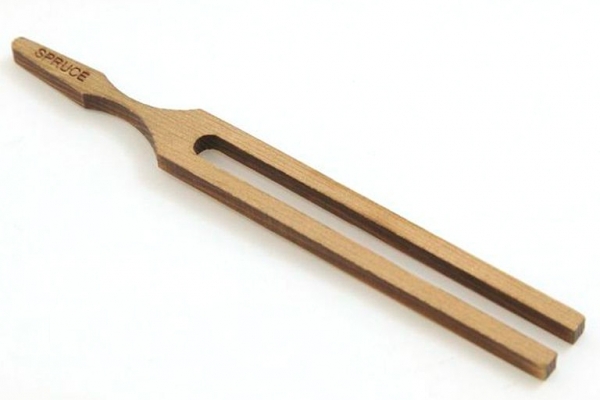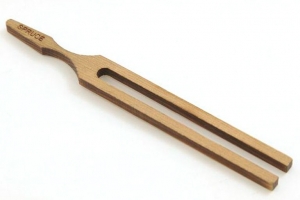
The tuning fork is an object with many uses: as an aid to tuning musical instruments, as a tool in hearing evaluations, or as an object of demonstration in school physics lessons. This spruce tuning fork is one of a set of 16 made out of an array of different materials to investigate their acoustic properties: a study that formed part of Director Zoe Laughlin’s PhD thesis. The three principle factors that influence the production of sound by a tuning fork are the shape of the fork, the density of the material from which the fork is made, and its elastic modulus (a measure of stiffness). These different factors affect the note that the fork produces and how long it rings for.
When played, the spruce tuning fork doesn’t produce an audible ring like most of the metal and glass tuning forks. Instead this wooden fork produces a single note that doesn’t last very long at all, and there is a real knack to getting a sound from it. You need to hold the base of the fork firmly in one hand and bring it close to your ear, before pinching the two prongs together and releasing them quickly, so that they vibrate. When played in this fashion, the fleeting sound produced is – surprisingly - higher in pitch than the brass fork, and is closer to that of the steel and gold forks.
Spruce is the overarching name given to a type of softwood produced by about 40 different types of coniferous tree that grow in the cold and temperate parts of the northern hemisphere, like the boreal forests of Alaska (Sitka spruce) and Scandinavia (Norway spruce). Although there are differences between these different spruce species, they commonly all have long fibres, making them very useful in the production of strong paper. They also have a compact, straight and parallel grain, making them very elastic, resistant to splitting and strong relative to their density. That’s why spruce has historically been used to make the masts of ships and the propeller blades of light aircraft and wind turbines.
Its structure also gives this wood its famed acoustic properties: spruce is especially useful as an acoustic dampener, absorbing some frequencies whilst enabling the propagation of others in the manner of an acoustic filter. Spruce does this particularly because of the parallel bands of hard and soft matter that constitute the grain of the material. This could account for the popularity of spruce as a material for making guitars faces and the sounding boards of high-quality pianos, thought its superior strength-to-weight ratio undoubtedly also plays a part.
Read a research paper about these objects here.
Sample ID: 734
Particularities
- State
- Object
- Compound
- Maker
- Zoe Laughlin
- Selections
- Sound
- Categories
- Vegetable
- Curiosities
- Relationships
- Acoustic | Aircraft | Conifer | Density | Elastic modulus | Elasticity | Form | Grain | Guitar | Light Weight | Piano | Pitch | Resonance | Ship | Softwood | Sound of Materials | Spruce | Strength | Strong | Tuning Fork | Wind turbine | Wood
Add materials you find interesting to your own selections.
Use the  button to select a material and get started.
button to select a material and get started.



